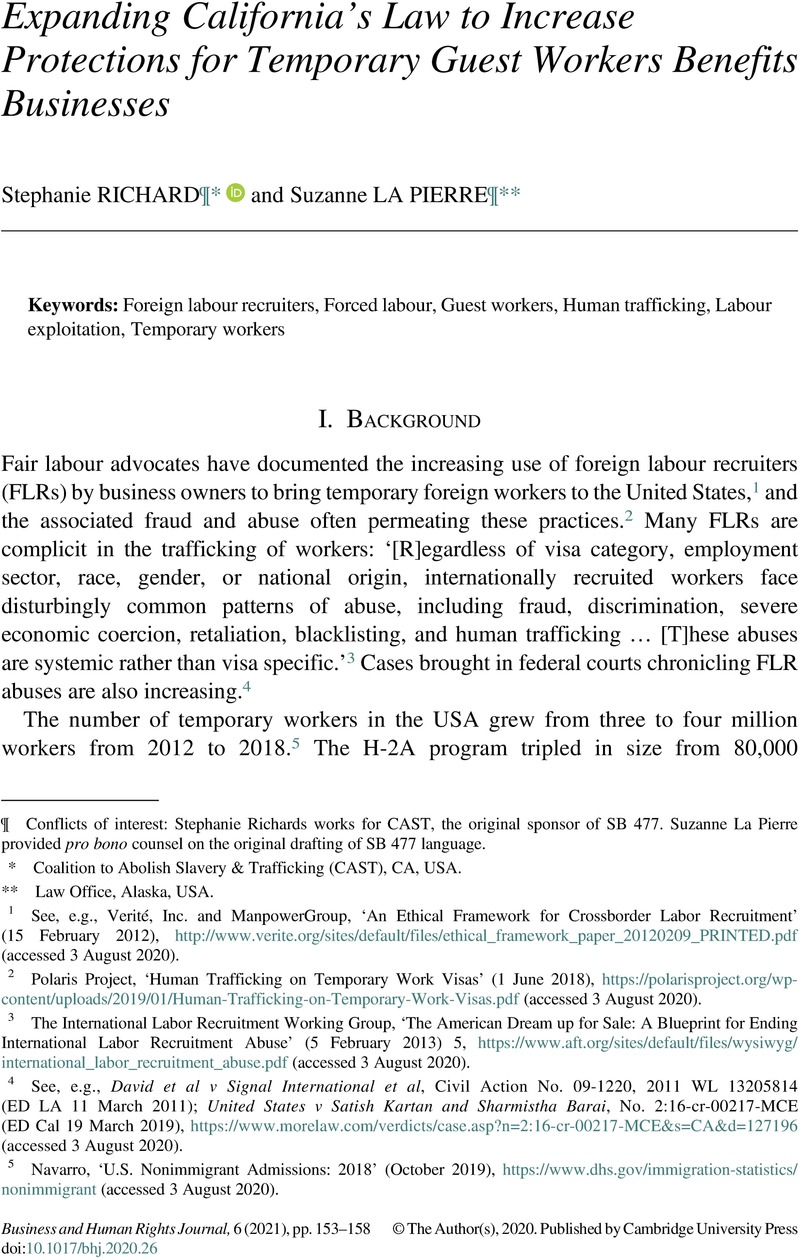Published online by Cambridge University Press: 14 December 2020

Conflicts of interest: Stephanie Richards works for CAST, the original sponsor of SB 477. Suzanne La Pierre provided pro bono counsel on the original drafting of SB 477 language.
Coalition to Abolish Slavery & Trafficking (CAST), CA, USA.
Law Office, Alaska, USA.
1 See, e.g., Verité, Inc. and ManpowerGroup, ‘An Ethical Framework for Crossborder Labor Recruitment’ (15 February 2012), http://www.verite.org/sites/default/files/ethical_framework_paper_20120209_PRINTED.pdf (accessed 3 August 2020).
2 Polaris Project, ‘Human Trafficking on Temporary Work Visas’ (1 June 2018), https://polarisproject.org/wp-content/uploads/2019/01/Human-Trafficking-on-Temporary-Work-Visas.pdf (accessed 3 August 2020).
3 The International Labor Recruitment Working Group, ‘The American Dream up for Sale: A Blueprint for Ending International Labor Recruitment Abuse’ (5 February 2013) 5, https://www.aft.org/sites/default/files/wysiwyg/international_labor_recruitment_abuse.pdf (accessed 3 August 2020).
4 See, e.g., David et al v Signal International et al, Civil Action No. 09-1220, 2011 WL 13205814 (ED LA 11 March 2011); United States v Satish Kartan and Sharmistha Barai, No. 2:16-cr-00217-MCE (ED Cal 19 March 2019), https://www.morelaw.com/verdicts/case.asp?n=2:16-cr-00217-MCE&s=CA&d=127196 (accessed 3 August 2020).
5 Navarro, ‘U.S. Nonimmigrant Admissions: 2018’ (October 2019), https://www.dhs.gov/immigration-statistics/nonimmigrant (accessed 3 August 2020).
6 Centro de los Derechos del Migrante, Inc. (CDM), ‘Ripe for Reform: Abuses of Agricultural Workers in the H-2A Visa Program’ (2020) 11,15, https://cdmigrante.org/wp-content/uploads/2020/04/Ripe-for-Reform.pdf (accessed 3 August 2020).
7 US GAO, ‘GAO 15-154, H-2A and H-2B Visa Programs: Increased Protections Needed for Foreign Workers’ (2015) 26, https://www.gao.gov/assets/690/684985.pdf (accessed 3 August 2020) (‘Actual percentages are likely higher than what employers voluntarily report.’).
8 M Twohey, M Rosenberg and R McNeill, ‘Brokers Recruiting Foreign Workers for U.S. Firms Compound Abuses’ Reuters (19 February 2016).
9 Royce, HR 3344-Fraudulent Overseas Recruitment and Trafficking Elimination (FORTE), Act 2013-2014 (US).
10 S Kara, Modern Slavery: A Global Perspective (Columbia University Press, 2017) 108.
11 Ibid, 88.
12 As originally drafted, SB 516 imposed joint and several liability on both FLRs and employers. In a compromise with the business community, it was amended to create a safe harbour for employers using a registered FLR.
13 The overwhelming majority of non-immigrant temporary workers in California use the services of an FLR. Using a conservative estimate of 95,000 workers, based on those for whom visas were actually requested in 2012, a fee of just US$10 per worker would cover the programme’s costs.
14 Despite documented abuses, due to business opposition, the J-I visa program was excluded from SB 516. Talent agency FLRs, whose licensing requirements impose more stringent obligations than SB 477, are also excluded.
15 Curing the problem requires deletion of California Business Code Section 9998 which reads: ‘This chapter shall apply only to “nonagricultural workers” as defined by Section 1101(a)(15)(H)(ii)(b) of Title 8 of the federal Immigration and Nationality Act.’
16 See generally 8 CA ADC § 13850 (2020).
17 See Centro de los Derechos del Migrante, ‘Fake Jobs for Sale: Analyzing Fraud and Advancing Transparency in U.S. Labor Recruitment’ (2019) 23, https://cdmigrante.org/wp-content/uploads/2019/04/Fake-Jobs-for-Sale-Report.pdf (accessed 3 August 2020).
18 B Rogers, ‘Toward Third-Party Liability for Wage Theft’ (2010) 31 Berkeley Journal of Employment and Labor 1, 20–21.
19 762 Fed Appx 859 (2019).
20 See Section II.
21 18 U.S.C. §§ 1593A, 1595 (a) 2016.
22 See, e.g., Doe v Tapia-Ortiz, 2016 WL 3414862 (MD Fla 22 June 2016); United States v Patel, No. CR 13-286, 2016 WL 80566 (ED La 7 January 2016); Ricchio v McLean, 853 F3d 553 (1st Cir 2017) and Ricchio v Bijal, Inc., 386 F Supp 3d 126 (D Mass 2019).
23 See Lesnik v Se, No. 16-CV-01120-LHK, 2019 US Dist LEXIS 47373 at *2–3, 57 (ND Cal 20 March 2019); Doe v Lorain-Elyria Motel, Inc., No. 2:19-CV-1194, 2019 WL 4929297, at *6 (SD Ohio 16 March 2020) (citing Brown v Corrections Corporation of America, 603 F Supp 2d 73, 81 (DDC 26 March 2009); M.A. v Wyndham Hotels & Resorts, Inc., No. 2:19-CV-849 (SD Ohio 7 October 2019); Bistline v Parker, No. 17-4020, 2019 US App LEXIS 7503, at *53–58 (10th Cir 14 March 2019); Gilbert v United States Olympic Commission, No. 18-cv-00981-CMA-MEH, 2019 US Dist LEXIS 35921 (D Colo 6 March 2019).
24 B Beltran, ‘The Hidden “Benefits” of the Trafficking Victim Protection Act’s Expanded Provisions for Temporary Foreign Workers’ (2019) 41:2 Berkeley Journal of Employment and Labor Law 45–46, https://ssrn.com/abstract=3448020 (accessed 3 August 2020).
25 Ibid, 46 (citing AF Levy, ‘Federal Human Trafficking Civil Litigation’, The Human Trafficking Legal Center (2018) 24–26, http://www.htlegalcenter.org/wp-content/uploads/Federal-Human-Trafficking-Civil-Litigation-1.pdf.
26 Castellanos-Contreras v Decatur Hotels LLC, 622 F.3d 393, 405 (5th Cir 2010) (en banc) (J Dennis, dissenting).
27 See Council on Foreign Relations, ‘U.S. Postwar Immigration Policy’, https://www.cfr.org/timeline/us-postwar-immigration-policy (cited in Centro de los Derechos del Migrante, notes 7, 13).
28 LGRP, ‘Driving Positive Change: About the Leadership Group’, Institute for Human Rights and Business (2016), https://www.ihrb.org/employerpays/leadership-group-for-responsible-recruitment (accessed 3 August 2020). Members include: Coca Cola, GE, Hewlett-Packard, IKEA, Mars, M&S, Nestle, Nike, Tesco, Target, Pepsico, Unilever, Vinci, Walmart, IHRB, Interfaith Center on Corporate Responsibility, International Organization for Migration/The UN Migration Agency, ILO, Verité and Migrant Forum in Asia.
29 ICCR, ‘Best Practice Guidance on Ethical Recruitment of Migrant Workers’ (2017) 6, https://www.iccr.org/best-practice-guidance-ethical-recruitment-migrant-workers-0 (accessed 4 August 2020).
30 See ‘AAFA/FLA Industry Commitment to Responsible Recruitment Signatories as of February 19, 2020’, https://www.aafaglobal.org/AAFA/Solutions_Pages/Commitment_to_Responsible_Recruitment (accessed 30 July 2020).
31 A Bateman and L Bonanni, ‘What Supply Chain Transparency Really Means’, Harvard Business Review (20 August 2019), https://hbr.org/2019/08/what-supply-chain-transparency-really-means.
32 Ibid (‘Patagonia and Nike have very high rates of applications for their jobs … Patagonia cites its employee turnover of less than 4% annually.’).